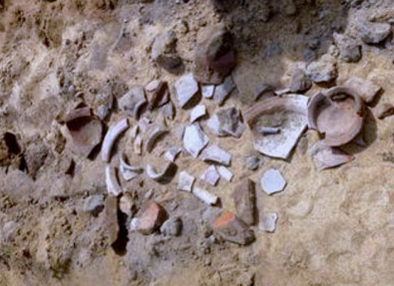S. Ganesan |
Source -http://www.thehindu.com/
The State Archaeology Department has unearthed pieces of a megalithic urn, presumably 2,500 years old, in Srirangam. The department recently discovered several icons and artefacts at Panchakarai on the banks of the Coleroon in the temple town.
|

|
|
Pieces of megalithic urn and potsherds that were unearthed in Srirangam [Credit: The Hindu]
|
Broken pieces of the urn and potsherds have been unearthed by the officials, just about 10 to 15 feet away from the site where the icons and other artefacts were found. However, the icons and artefacts belong to a much later period (12-13th centuries).
The potsherds were found in layers of sand that characterise the river bank. Black and red ware, pieces of bowls (kalayam) made of burnt clay, two Sangam-age burnt clay bricks, parts of a ring well and pieces of the mouth portion of a burnt clay pot with rings around were among the find. The discovery was made by G. Muthusamy, Registering Officer, Archaeology Department, Tiruchi, and his team during a field inspection taken up after the unearthing of the icons.
The find was significant as it indicated that the area had been inhabited for about 2,500 years, Mr. Muthusamy told The Hindu .
Agreeing that the find is of historic importance, K. Sridharan, former deputy director of the department, said this was the first time megalithic urn pieces had been found in Srirangam indicating that the area had been inhabited 2000 to 2,500 years ago and people had resorted to urn burials. Equally significant was the unearthing of the exquisite and artistic icons.
Mr.Muthusamy, who also examined the panchaloka icons that were unearthed on January 11 and 12, said they belonged to 12-13th centuries. “All the icons are less than a feet in height, indicating that they had been used for the personal worship at a house or mutt, probably by a Vaishnava Acharya. The icons have artistic features usually found in idols at temples. They could have been buried after the Acharya passed away or the worship had stopped.”
The icons found inside a copper pot include those of Navaneethakrishnar, Narasimhar and Lakshmi in seated posture, Varagamurthy with Bhoomadevi, Thirumal-Sridevi-Bhoodevi, Krishnar-Bhama-Rukmani, Sri Ramar-Lakshman-Seetha and Hanuman bowing before Sri Rama, besides those of Thayar and Azhvars.
Pooja artefacts such as zinc pot of about four litres capacity, apparently used for bringing water from Cauvery, a kuthuvilakku, akal vilakku, a theertha kendi, thiruvasis (arches), small pedestals, and thiruvadis were also part of the find.